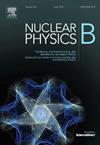量子场论中Araki-Uhlmann相对熵的数值分析
IF 2.8
3区 物理与天体物理
Q2 PHYSICS, PARTICLES & FIELDS
引用次数: 0
摘要
本文对量子场论中的Araki-Uhlmann相对熵进行了数值研究,重点研究了1+1维闵可夫斯基时空中的自由大质量标量场。利用Tomita-Takesaki模理论,分析了相干态和真空态之间的相对熵,并在右伦德勒楔中定位了几种测试函数。我们的结果证实,相对熵随着质量的增加而减少,并随着时空区域的大小而增加,这与理论预期一致。本文章由计算机程序翻译,如有差异,请以英文原文为准。
A numerical analysis of Araki-Uhlmann relative entropy in Quantum Field Theory
We numerically investigate the Araki-Uhlmann relative entropy in Quantum Field Theory, focusing on a free massive scalar field in -dimensional Minkowski spacetime. Using Tomita-Takesaki modular theory, we analyze the relative entropy between a coherent state and the vacuum state, with several types of test functions localized in the right Rindler wedge. Our results confirm that relative entropy decreases with increasing mass and grows with the size of the spacetime region, aligning with theoretical expectations.
求助全文
通过发布文献求助,成功后即可免费获取论文全文。
去求助
来源期刊

Nuclear Physics B
物理-物理:粒子与场物理
CiteScore
5.50
自引率
7.10%
发文量
302
审稿时长
1 months
期刊介绍:
Nuclear Physics B focuses on the domain of high energy physics, quantum field theory, statistical systems, and mathematical physics, and includes four main sections: high energy physics - phenomenology, high energy physics - theory, high energy physics - experiment, and quantum field theory, statistical systems, and mathematical physics. The emphasis is on original research papers (Frontiers Articles or Full Length Articles), but Review Articles are also welcome.
 求助内容:
求助内容: 应助结果提醒方式:
应助结果提醒方式:


